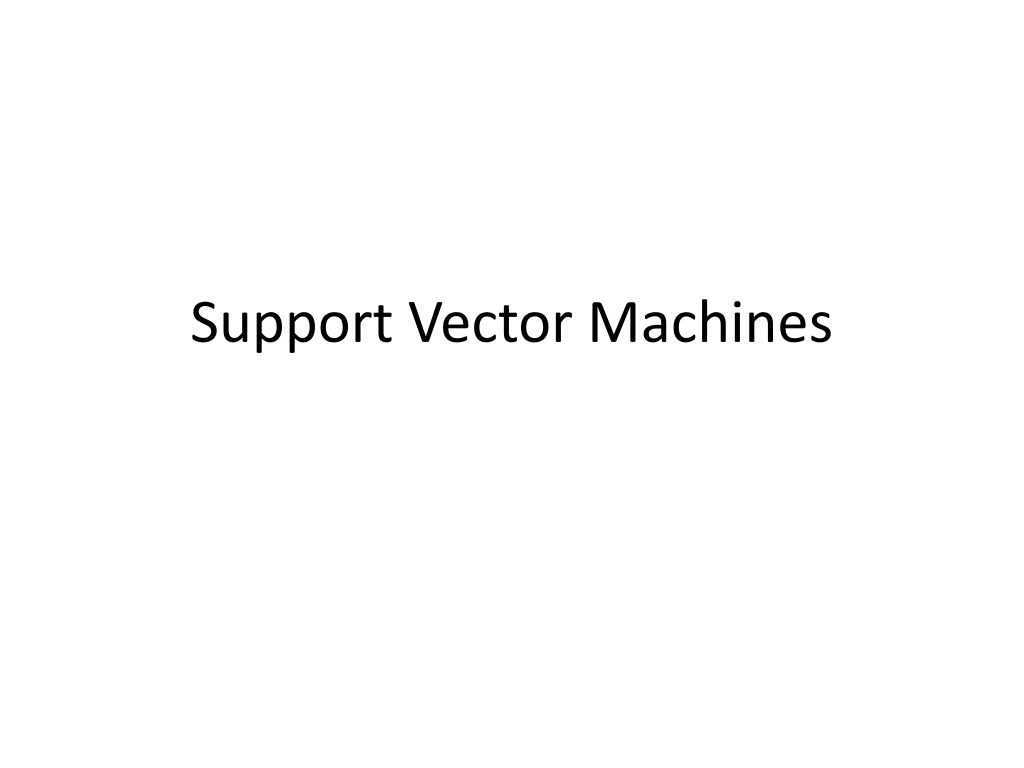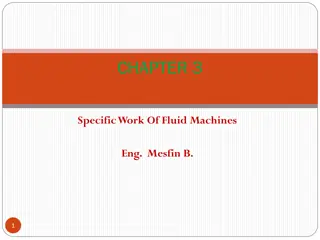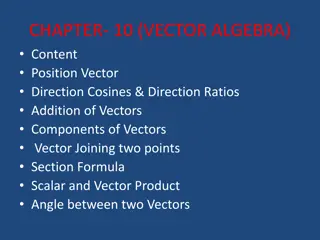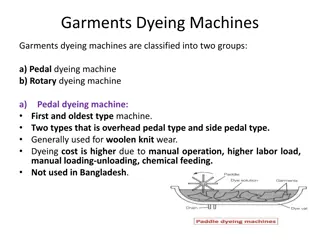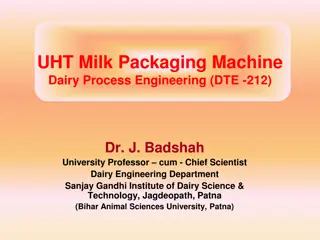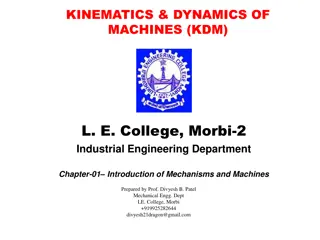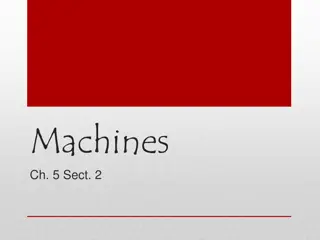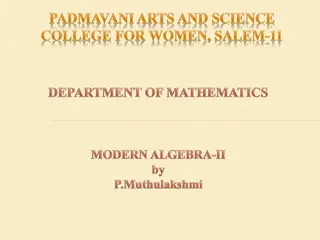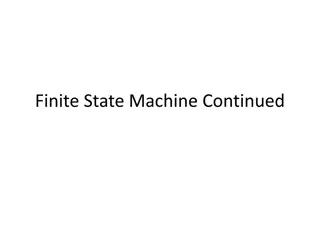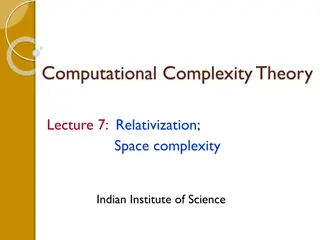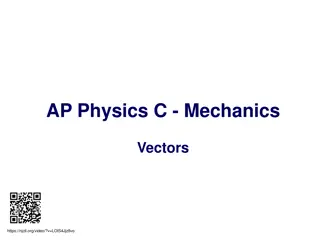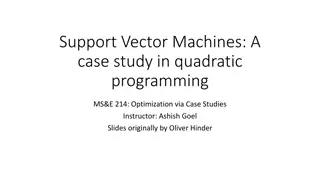Support Vector Machines
A comprehensive overview of Support Vector Machines (SVM), a popular machine learning algorithm used for classification and regression tasks. Learn about the principles behind SVM, how it works, its strengths and weaknesses, and practical applications in various fields such as finance, healthcare, and image recognition. Delve into the optimization techniques, kernel functions, and tuning parameters that enhance SVM performance, making it a valuable tool in predictive modeling and data analysis.
Download Presentation

Please find below an Image/Link to download the presentation.
The content on the website is provided AS IS for your information and personal use only. It may not be sold, licensed, or shared on other websites without obtaining consent from the author.If you encounter any issues during the download, it is possible that the publisher has removed the file from their server.
You are allowed to download the files provided on this website for personal or commercial use, subject to the condition that they are used lawfully. All files are the property of their respective owners.
The content on the website is provided AS IS for your information and personal use only. It may not be sold, licensed, or shared on other websites without obtaining consent from the author.
E N D
Presentation Transcript
Linear Separators Binary classification can be viewed as the task of separating classes in feature space: wTx + b = 0 wTx + b > 0 wTx + b < 0 f(x) = sign(wTx + b)
Linear Separators Which of the linear separators is optimal?
What is a good Decision Boundary? Many decision boundaries! The Perceptron algorithm can be used to find such a boundary Are all decision boundaries equally good? Class 2 Class 1 4
Examples of Bad Decision Boundaries Class 2 Class 2 Class 1 Class 1 5
Finding the Decision Boundary Let {x1, ..., xn} be our data set and let yi {1,-1} be the class label of xi +b +b T w 1 w x For yi=1 For yi=-1 i T 1 x i y=1 y=1 So: ( ) ( ) y=1 + T , 1 , y w x b x y y=-1 y=1 i i i i y=1 y=-1 Class 2 y=-1 y=-1 y=-1 m y=-1 Class 1 6
Large-margin Decision Boundary The decision boundary should be as far away from the data of both classes as possible We should maximize the margin, m Class 2 m Class 1 7
Finding the Decision Boundary The decision boundary should classify all points correctly The decision boundary can be found by solving the following constrained optimization problem This is a constrained optimization problem. Solving it requires to use Lagrange multipliers 8
Finding the Decision Boundary The Lagrangian is i 0 Note that ||w||2 = wTw 9
Gradient with respect to w and b Setting the gradient of w.r.t. w and b to zero, we have ( = + = i k 1 1 2 n: no of examples, m: dimension of the space ( ) ) 1 n = + + = T T 1 L w w y w x b i i i 2 1 i 1 m n m = = = k k + k k k 1 w w y w x b i i i 1 w L = , 0 k k L = 0 b 10
The Dual Problem If we substitute to , we have Since This is a function of i only 11
The Dual Problem The new objective function is in terms of i only It is known as the dual problem: if we know w, we know all i; if we know all i, we know w The original problem is known as the primal problem The objective function of the dual problem needs to be maximized (comes out from the KKT theory) The dual problem is therefore: Properties of i when we introduce the Lagrange multipliers The result when we differentiate the original Lagrangian w.r.t. b 12
The Dual Problem This is a quadratic programming (QP) problem A global maximum of i can always be found w can be recovered by 13
Characteristics of the Solution Many of the i are zero w is a linear combination of a small number of data points This sparse representation can be viewed as data compression as in the construction of knn classifier xi with non-zero i are called support vectors (SV) The decision boundary is determined only by the SV Let tj (j=1, ..., s) be the indices of the s support vectors. We can write Note: w need not be formed explicitly 14
A Geometrical Interpretation Class 2 10=0 8=0.6 7=0 2=0 5=0 1=0.8 4=0 6=1.4 9=0 3=0 Class 1 15
Characteristics of the Solution For testing with a new data z Compute and classify z as class 1 if the sum is positive, and class 2 otherwise Note: w need not be formed explicitly 16
The Quadratic Programming Problem Many approaches have been proposed Loqo, cplex, etc. (see http://www.numerical.rl.ac.uk/qp/qp.html) Most are interior-point methods Start with an initial solution that can violate the constraints Improve this solution by optimizing the objective function and/or reducing the amount of constraint violation For SVM, sequential minimal optimization (SMO) seems to be the most popular A QP with two variables is trivial to solve Each iteration of SMO picks a pair of ( i, j) and solve the QP with these two variables; repeat until convergence In practice, we can just regard the QP solver as a black- box without bothering how it works 17
Non-linearly Separable Problems We allow error i in classification; it is based on the output of the discriminant function wTx+b i approximates the number of misclassified samples Class 2 Class 1 18
Soft Margin Hyperplane The new conditions become iare slack variables in optimization Note that i=0 if there is no error for xi i is an upper bound of the number of errors We want to minimize 1 n = i 2 + w C i 2 1 C : tradeoff parameter between error and margin 19
The Optimization Problem ( 1 ( ) ) 1 n n n = i = i = + + + T T L w w C y w x b i i i i i i i 2 = 1 1 1 i With and Lagrange multipliers, POSITIVE n n L = = i = = = 0 w y x 0 w y x i i i j i i ij w = 1 i 1 j L = = 0 C j j j n L = i = = 0 iy i b 1 20
The Dual Problem 1 n n n = 1 = i T = i + + L y y x x C j i j i j i 2 = 1 1 1 i j n n n = i = j = i T + + y y x x b i i i j j j i i i 1 1 1 n = i = + C With iy = 0 j j i 1 1 n n n = i 1 = i T = i + L y y x x j i j i j i 2 = 1 1 j
The Optimization Problem The dual of this new constrained optimization problem is = + C New constrainsderive from since and are positive. w is recovered as j j This is very similar to the optimization problem in the linear separable case, except that there is an upper bound C on i now Once again, a QP solver can be used to find i 22
1 n = i 2 + w C i 2 1 The algorithm try to keep null, maximising the margin The algorithm does not minimise the number of error. Instead, it minimises the sum of distances fron the hyperplane When C increases the number of errors tend to lower. At the limit of C tending to infinite, the solution tend to that given by the hard margin formulation, with 0 errors 2/27/2025 23
Extension to Non-linear Decision Boundary So far, we have only considered large-margin classifier with a linear decision boundary How to generalize it to become nonlinear? Key idea: transform xi to a higher dimensional space to make life easier Input space: the space the point xi are located Feature space: the space of (xi) after transformation Why transform? Linear operation in the feature space is equivalent to non-linear operation in input space Classification can become easier with a proper transformation. In the XOR problem, for example, adding a new feature of x1x2 make the problem linearly separable 25
XOR Is not linearly separable X Y 0 0 0 0 1 1 1 0 1 1 1 0 Is linearly separable X Y XY 0 0 0 1 0 0 0 1 1 0 0 1 1 1 1 0 26
Transforming the Data ( ) ( ) ( ) ( ) ( ) ( ) (.) ( ) ( ) ( ) ( ) ( ) ( ) ( ) ( ) ( ) ( ) ( ) ( ) Feature space Note: feature space is of higher dimension than the input space in practice Input space Computation in the feature space can be costly because it is high dimensional The feature space is typically infinite-dimensional! The kernel trick comes to rescue 28
Transforming the Data ( ) ( ) ( ) ( ) ( ) ( ) (.) ( ) ( ) ( ) ( ) ( ) ( ) ( ) ( ) ( ) ( ) ( ) ( ) Feature space Note: feature space is of higher dimension than the input space in practice Input space Computation in the feature space can be costly because it is high dimensional The feature space is typically infinite-dimensional! The kernel trick comes to rescue 29
The Kernel Trick Recall the SVM optimization problem The data points only appear as inner product As long as we can calculate the inner product in the feature space, we do not need the mapping explicitly Many common geometric operations (angles, distances) can be expressed by inner products Define the kernel function K by 30
An Example for (.) and K(.,.) Suppose (.) is given as follows An inner product in the feature space is So, if we define the kernel function as follows, there is no need to carry out (.) explicitly This use of kernel function to avoid carrying out (.) explicitly is known as the kernel trick 31
Kernels Given a mapping: a kernel is represented as the inner product i x (x) x y (x) (y) ( , ) K i i A kernel must satisfy the Mercer s condition: 2 x x x x, y x y x y ( such that ) ( ) 0 ( ) ( ) ( ) 0 g g d K g g d d 32
Modification Due to Kernel Function Change all inner products to kernel functions For training, Original With kernel function 33
Modification Due to Kernel Function For testing, the new data z is classified as class 1 if f 0, and as class 2 if f <0 Original With kernel function 34
More on Kernel Functions Since the training of SVM only requires the value of K(xi, xj), there is no restriction of the form of xi and xj xi can be a sequence or a tree, instead of a feature vector K(xi, xj) is just a similarity measure comparing xi and xj For a test object z, the discriminant function essentially is a weighted sum of the similarity between z and a pre-selected set of objects (the support vectors) 35
Example Suppose we have 5 1D data points x1=1, x2=2, x3=4, x4=5, x5=6, with 1, 2, 6 as class 1 and 4, 5 as class 2 y1=1, y2=1, y3=-1, y4=-1, y5=1 36
Example class 1 class 1 class 2 1 2 4 5 6 37
Example We use the polynomial kernel of degree 2 K(x,y) = (xy+1)2 C is set to 100 We first find i (i=1, , 5) by 38
Example By using a QP solver, we get 1=0, 2=2.5, 3=0, 4=7.333, 5=4.833 Note that the constraints are indeed satisfied The support vectors are {x2=2, x4=5, x5=6} The discriminant function is b is recovered by solving f(2)=1 or by f(5)=-1 or by f(6)=1, All three give b=9 39
Example Value of discriminant function class 1 class 1 class 2 1 2 4 5 6 40
Kernel Functions In practical use of SVM, the user specifies the kernel function; the transformation (.) is not explicitly stated Given a kernel function K(xi, xj), the transformation (.) is given by its eigenfunctions (a concept in functional analysis) Eigenfunctions can be difficult to construct explicitly This is why people only specify the kernel function without worrying about the exact transformation Another view: kernel function, being an inner product, is really a similarity measure between the objects 41
A kernel is associated to a transformation Given a kernel, in principle it should be recovered the transformation in the feature space that originates it. K(x,y) = (xy+1)2= x2y2+2xy+1 2 x 2 x x It corresponds the transformation 1 2/27/2025 42
Examples of Kernel Functions Polynomial kernel up to degree d Polynomial kernel up to degree d Radial basis function kernel with width The feature space is infinite-dimensional Sigmoid with parameter and It does not satisfy the Mercer condition on all and 43
Example 44
Building new kernels If k1(x,y) and k2(x,y) are two valid kernels then the following kernels are valid Linear Combination ) , ( ) , ( 1 1 c y x k c y x k + = ) , ( exp ) , ( 1 y x k y x k = ( , ) k x y 2 2 Exponential Product ( x k = , ) ( , ) ( , ) y k x y k x y 1 2 Polymomial tranfsormation (Q: polymonial with non negative coeffients) ) , ( ) , ( 1 y x k Q y x k = Function product (f: any function) ) ( ) , ( x f y x k = ( , ) ( ) k x y f y 1 45
Ploynomial kernel Ben-Hur et al, PLOS computational Biology 4 (2008) 46
Gaussian RBF kernel Ben-Hur et al, PLOS computational Biology 4 (2008) 47
Spectral kernel for sequences Given a DNA sequence x we can count the number of bases (4-D feature space) x = ( ) ( , , , ) n n n n 1 A C G T Or the number of dimers (16-D space) , , ( ) ( 2 AC AA n n n x = , , , , , ,..) n n n n n AG AT CA CC CG CT Or l-mers (4l D space) ( ) x ( ) y = The spectral kernel is ( , ) k x y l l l 2/27/2025 48
Choosing the Kernel Function Probably the most tricky part of using SVM. The kernel function is important because it creates the kernel matrix, which summarizes all the data Many principles have been proposed (diffusion kernel, Fisher kernel, string kernel, ) There is even research to estimate the kernel matrix from available information In practice, a low degree polynomial kernel or RBF kernel with a reasonable width is a good initial try Note that SVM with RBF kernel is closely related to RBF neural networks, with the centers of the radial basis functions automatically chosen for SVM 49
Other Aspects of SVM How to use SVM for multi-class classification? One can change the QP formulation to become multi-class More often, multiple binary classifiers are combined See DHS 5.2.2 for some discussion One can train multiple one-versus-all classifiers, or combine multiple pairwise classifiers intelligently How to interpret the SVM discriminant function value as probability? By performing logistic regression on the SVM output of a set of data (validation set) that is not used for training Some SVM software (like libsvm) have these features built-in 50
